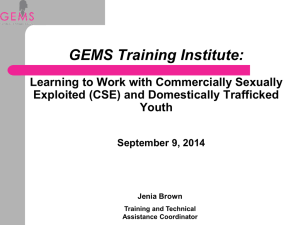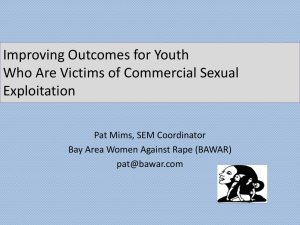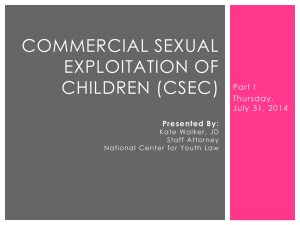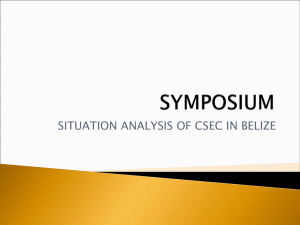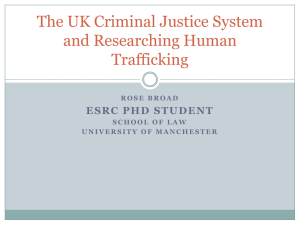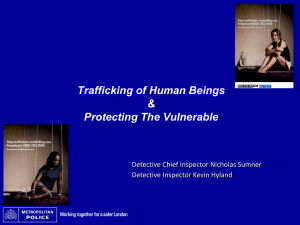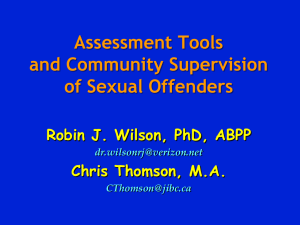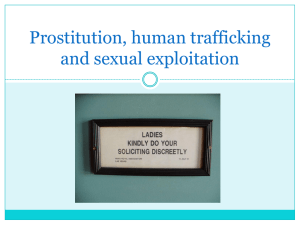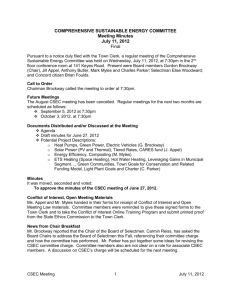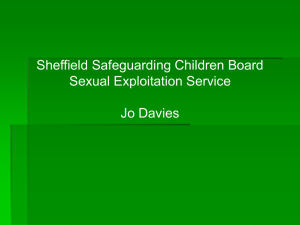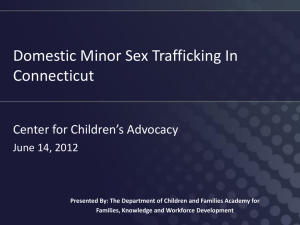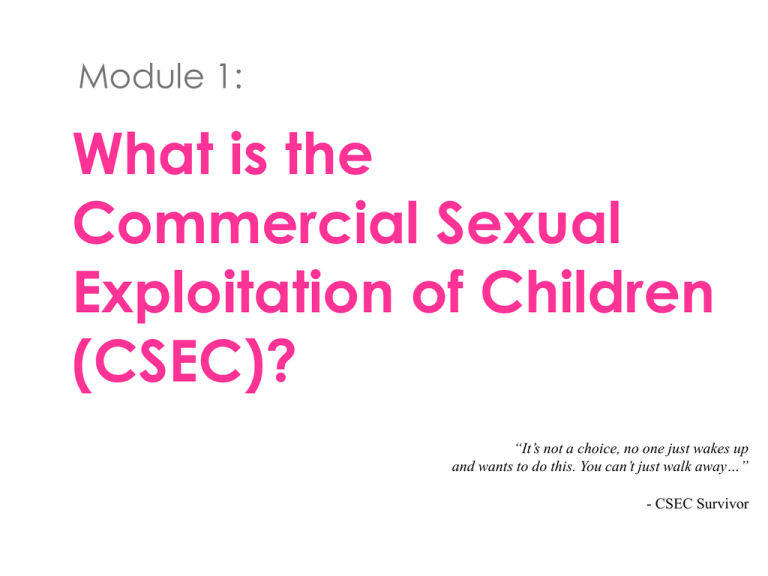
Module 1:
What is the
Commercial Sexual
Exploitation of Children
(CSEC)?
“It’s not a choice, no one just wakes up
and wants to do this. You can’t just walk away…”
- CSEC Survivor
What is CSEC?
Objectives…
• Dispel commonly held beliefs and stereotypes that promote CSEC
• Define terms needed to discuss and understand issues of CSEC
• Understand the forms and prevalence of CSEC within the U.S.
• Frame issues of CSEC in a regional context and understand the
scope and forms of CSEC in your community
• Increase awareness and sensitivity to CSEC issues according to a
philosophy that promotes victim centered programming,
investigation, and prosecution
Activity:
Language and Sensitivity
Activity: Language and Sensitivity
Group Questions:
– What first comes to mind when you hear these
terms?
– What ideas/images/concepts are
communicated through these terms?
– How do these terms impact how children are
seen and treated?
– How do these terms impact how the issue of
CSEC is addressed?
Language and Sensitivity
Question:
What difference does it make to change the
language we use to talk about CSEC or
sexually exploited children?
Changing the Language:
• Reframes the issue as a form of child abuse
• Expresses the philosophy that sexually exploited
children deserve support services instead of jail
sentences
• More accurately represents the scope of the issue
and the reality of exploited youth’s experiences
• Creates a common language to facilitate moving
toward facilitating a community response plan
What are some myths and
stereotypes about CSEC or
sexually exploited children?
CSEC is….
The commercial sexual exploitation of
children (CSEC) is:
– Sexual activity involving a child in exchange for
something of value, or promise thereof, to the
child or another person or persons.
– The child is treated as a commercial and sexual
object.
– CSEC is a form violence against children.
CSEC includes:
–
–
–
–
–
–
–
–
–
–
street prostitution
pornography
stripping
erotic/nude massage
escort services
phone sex lines
private parties
gang-based prostitution
interfamilial pimping
forms of Internet-based exploitation
Intersections of Abuse
Child Sexual Abuse (CSA)
Any sexual activity with a child where
consent is not or cannot be given. The
sexually abusive acts may include
penetration, creation of pornographic
images, sexual touching, or non-contact
acts such as exposure or voyeurism.
(Based on Berliner & Elliott, 2002)
Sexual Exploitation of Children (SEC)
• Taking unfair advantage of the imbalance of power
between an adult and a youth or child under the
age of 18 for the purpose of sexual pleasure.
• Can also involve remuneration in money, goods, or
services, or the promise of money, goods, or
services to the child.
Intersections of Abuse
Child Sexual Abuse
Sexual Exploitation of Children
Commercial Sexual
Exploitation of Children
Domestic
Minor Sex
Trafficking
Domestic Minor Sex Trafficking (DMST)
Domestic Minor Sex Trafficking (DMST)
consists of all forms of CSEC. It occurs
when a US citizen or legal permanent
resident of the US who has not
attained 18 years of age is engaged in
a commercial sex act.
Sex Trafficking
FACT:
The Trafficking Victims Protection Act (TVPA) of 2000
recruitment,
harboring, transportation,
provision, or obtaining of a person
defines “sex trafficking” as the
for a commercial sex act or in which the person
induced to perform such as act is under 18 years of
age. When a minor is trafficked for a commercial
sex act, there is no need to prove force, fraud, or
coercion.
Sex Trafficking
(continued)
MYTH:
• Trafficking is defined by the crossing of state
or national borders.
• Only foreign nationals can be victims of
trafficking.
Florida Safe Harbor Act
The “Florida Safe Harbor Act,” amends
current legislation to allow a law
enforcement officer who takes a child for
whom there is “probable cause” to believe
that he or she has been sexually exploited
into custody to deliver the child to the
department of Children and Family Services,
in lieu of arrest. F.S. 39.401
Definitions
The bill also amends the definitions of
the terms “child who is found to be
dependent” and “sexual abuse of a
child” to reference sexual exploitation,
expanding the definition to include
“engaging in prostitution”. 39.01(67)(g)
Short Term Safe House/Safe
House
The bill also seeks to provide
a process for the
assessment and placement
of sexually exploited children
in a safe house when
available. F.S. 39.524 &
409.1678
CHILD ADVOCATES
Employees of short-term houses must
be trained to work with and advocate
for the needs of sexually exploited
children and assist them throughout
any legal proceedings. F.S. 409.1678
Detain
Safe Harbor services
as probation
condition?
DELINQUENC
Y
Youth
referred to
DJJ
Allegations of
sexual
exploitation
L
E
Call to DCF
Hotline
DCF CPI
determines
probable
cause for
sexual
exploitation
Release & Refer
Safe Harbor services
as diversion?
PUBLIC/MANDATORY
REPORTERS
Dependenc
y Path –
no capable
caregiver
Nondependenc
y Path
DEPENDENCY
Short
Term
Safe
House,
if
availabl
e
Safe
Harbor
Assessme
nt
Condition of
probation or
diversion
CBC or social
service agency
referral
Voluntary
Dependency
Hearing
Referra
l for
service
s
DCF performs
Comprehensive
Assessment
Safe
House, if
available
Referral for
ongoing
victim
assistance
CSEC in the United States
• It is estimated that
100,000 to 300,000
youth could be at risk for commercial
sexual exploitation annually in the U.S. (Estes and
Wiener, 2001)
• The average age of entry into the
commercial sex industry in the U.S. is 12
years old. (US Department of Justice, Child Exploitation and
Obscenity Section)
CSEC in the United States
The National Incidence Studies of Missing,
Abducted, Runaway, and Throwaway
(NISMART) children estimate that 1.6 million
children run away from home each year in
the U.S.
One in three teens will be recruited by a
pimp within 48 hours of leaving home and
becoming homeless.
Kristi House
Miami, FL
Federal, National and International Responses to CSEC
Federal Responses
US Department of Justice (DOJ)
Office of Justice Programs (OJP)
Office of Juvenile Justice and Delinquency Prevention (OJJDP)
National Center for Missing and Exploitation Children (NCMEC)
Internet Crimes Against Children (ICAC) task forces
Child Exploitation and Obscenity Section (CEOS)
Criminal Division of the Department of Justice (DOJ)
FBI Crimes Against Children (CAC) squad
Innocence Lost Task Forces
DOJ/OJP Office for Victims of Crime (OVC).
DOJ/OJP Bureau of Justice Assistance (BJA)
Human Trafficking Task Forces
DOJ Civil Rights Division
Human Trafficking Prosecution Unit (HTPU)
Department of Homeland Security Immigration and Customs Enforcement (ICE): Operation
Predator
Department of State The Office to Monitor and Combat Trafficking in Persons (G-TIP)
Department of Health and Human Services (HHS)
Federal, National and International Responses (continued)
Federal Responses Continued
The Unaccompanied Refugee Minor (URM)
U.S. Conference of Catholic Bishops (USCCB)
Lutheran Immigrant and Refugee Services (LIRS)
Division of Unaccompanied Children’s Services (DUCS)
Department of Education
The Office of Safe and Drug-Free Schools
Other National Responses
The Fund for Nonviolence Launched the U.S. Campaign Against CSEC in 2003
GEMS sponsored a Congressional Youth Summit in 2003
The U.S. Mid-Term Review of CSEC is sponsored by Shared Hope International, ECPAT, and the
Protection Project
International Responses
First World Congress in Stockholm, Sweden in 1996
Second World Congress in Yokohama, Japan in 2001
Third World Congress is projected to occur again in 2008
Federal Legislation that Addresses CSEC
• The Trafficking Victims Protection Act (TVPA)
of 2000, and its subsequent Reauthorizations
in 2003 and 2005
• The PROTECT Act of 2003
• The Adam Walsh Child Protection and
Safety Act of 2006
• The Mann Act of 1910 (Also known as the
White Slave Traffic Act)
SPOTLIGHT: Trafficking Victims Protection Reauthorization Act
(TVPRA) of 2005
Title II Provisions of the TVPRA of 2005 outline a
Federal commitment to:
• New prevention initiatives
• Research studies and statistical review of severe
forms of trafficking
• Grant programs to increase services to victims,
including U.S. citizen victims
• Residential treatment centers and shelter
programs for minor victims of sex trafficking
• Training for law enforcement
• Grant programs for law enforcement to address
demand reduction initiatives
Question:
What impact do federal
responses to CSEC have
at the local level?
Addressing Demand
If at least 300,000 children are
estimated to be at risk for CSEC in
the U.S….
who do you think is buying
children for sex?
Addressing Demand
Pedophile
An adult who over a period of at least six
months, has recurrent intense sexual urges
and sexually arousing fantasies involving
sexual activity with a prepubescent child or
children (generally age 13 or younger).*
Ephebophilia/Hebephilia
Adult who has a strong or exclusive
attraction to post-pubescent
child/adolescent.
*Diagnostic and Statistical Manual of Mental Disorders, DSM-IV-TR.
Addressing Demand
Situational Abusers
Adults who use children for sex not because they have a
predisposition to do so but just because they want to or find
themselves in a situation where it is possible. Such men
engage in the criminal activity of sex with minors (under-18s)
without necessarily feeling any real sexual attraction towards
them.
May be family men with regular partners and in every way
'normal' lives. For this reason they are particularly difficult to
identify and often are protected by those around them who
find it impossible to accept that 'Mr. Normal' next door - or
their husband/brother/son - could possibly have sex with
children.
Addressing Demand
Reflection Questions:
• Why do you think there is such a huge
demand?
• What factors in our society contribute
to demand?
Factors Influencing Demand
Presence of Adult Sex Industry
“Without equivocation….the presence of preexisting adult prostitution markets contributes
measurably to the creation of secondary sexual
markets in which children are sexually exploited.
[W]e find no support for the legalization of
prostitution in the U.S., especially given the
relationship that we can confirm to exist between
adult and juvenile sexual exploitation”.
The Commercial Sexual Exploitation of Children, Estes & Weiner (2001).
Factors Influencing Demand
Acceptance of Violence Towards Individuals
in Sex Industry
A Canadian commission found that prostituted
women are 40 times more likely to be murdered than
their non-prostituted counterparts.
Special Committee on Prostitution and Pornography, Pornography and Prostitution in Canada, 350,(1985).
Factors Influencing Demand
Dehumanization of Prostituted Women
"I picked prostitutes as my victims because I hate
most prostitutes and I did not want to pay them for
sex. I also picked prostitutes as victims because they
were easy to pick up, without being noticed. I knew
they would not be reported missing right away, and
might never be reported missing. I picked prostitutes
because I thought I could kill as many of them as I
wanted without getting caught.”
Gary Ridgway,(The ‘Green River Killer’) in a statement to the Court in which he pled guilty to murdering
48 women and girls, 2003.
Factors Influencing Demand
Dehumanization of Prostituted Women
“They were objects. In my mind, they never had
families or anything."
Joel Rifkin, in a statement to the police in admitting to the murders of 17 prostituted women, many of
whose names he could not remember, 1994.
Factors Influencing Demand
Dehumanization of CSEC Victims
Of Gary Ridgway’s 48 admitted victims, 27 of those
victims were between the ages of 15-18 years old.
The Green River Killer was therefore one of the
largest child serial killers in the US ever, and the
largest known killer of CSEC victims, yet the fact that
many of his victims were children/youth is never
mentioned because they were viewed as
‘prostitutes’.
Factors Influencing Demand
No Perceived Consequences
In 2004, Chicago police arrested 3,204 prostitutes
and 950 johns.
“Last year, Chicago Police arrested 950 prostitution
customers. That comes to less than three per day in
the entire city, so you tell me if that sounds like a
commitment to dealing with the demand for
prostitution. They could make 20 or more arrests
here a day.”
Chicago Coalition for the Homeless.
City doesn't have to look far to find johns. Chicago Sun Times, 2005.
Factors Influencing Demand
Internet Pornography
There are over 100,000 sites offering illegal child
pornography and hundreds of thousands more
offering legal ‘teen’ or ‘ barely legal’ pornography.
In 2006, there were over 20 million searches using
the words ‘teen porn’ or ‘teen sex’.
http://internet-filter-review.toptenreviews.com/internet-pornography-statistics.html
Reflection Questions:
Why do you think that our society
doesn’t address demand more?
Why don’t we arrest the johns?
Film:
CNN Anderson Cooper 360:
“Invisible Chains: Sex, Work,
and Slavery”
CNN: Anderson Cooper 360
Discussion Questions:
Are there any points or themes that we
that we discussed in this module that
are covered in this clip?
What are your reactions to these
themes?
Activity:
Who? What? Where? Why?
Activity: Who? What? Where? Why?
Directions for groups:
• Based on your knowledge and experience, choose
one of four sets of questions: Who? What? Where?
or Why?
• In your group, review the set of questions you
selected. Be as specific, detailed, and reflective in
your responses as possible. Record your answers on
a piece of easel paper.
• Choose one group member to present your
responses to the whole group.

